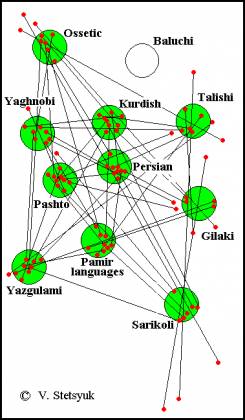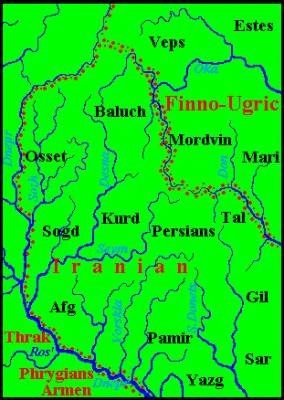
Iranian Tribes
We know that the original unitary Iranian language had split on many languages of higher level with complicated relationships. At present such Iranian languages exist: the Ossetic, Yaghnobi, Pashto, Parachi, Ormuri, Yazgulami, Ishkashimi, Wakhi, Persian, Tadjik, Kurdish, Baluchi, Talishi, Gilaki, Mazandarani, Kumzari, the dialects of Phars, small languages of Central Iran, the Luri and Bachtiar dialects, the dialects of Shughni-Roshani language group (EDELMAN D.I., 1968).
Lang |
Ossetic |
Yaghn |
Kurdish |
Pashto |
Talishi |
Persian |
Pamir |
Gilaki |
Yazgul |
Sarikol |
Baluchi |
Ossetic |
437 |
||||||||||
Yaghnob |
208 |
500 |
|||||||||
Kurdish |
212 |
201 |
588 |
||||||||
Pashto |
173 |
231 |
272 |
595 |
|||||||
Talishi |
114 |
157 |
243 |
194 |
430 |
||||||
Persian |
208 |
288 |
364 |
441 |
266 |
755 |
|||||
Pamir |
115 |
225 |
192 |
245 |
131 |
298 |
554 |
||||
Gilaki |
90 |
154 |
224 |
222 |
198 |
329 |
173 |
425 |
|||
Yazgul |
111 |
168 |
146 |
187 |
94 |
206 |
287 |
113 |
418 |
||
Sarikol |
63 |
124 |
101 |
126 |
72 |
149 |
225 |
91 |
147 |
319 |
|
Baluchi |
20 |
24 |
25 |
19 |
15 |
24 |
18 |
16 |
12 |
10 |
39 |
The Yaghnobi language is a successor of the extinct Sogdian language therefore these two languages can be united into one language. The Iranian tribes of Sackes and Massagetes were in existence in the 1st mill BC. But it is still unknown what languages they were speaking. Thus it is very difficult to investigate the relationships of Iranian languages. However, comparative analysis of Iranian vocabulary was performed using etymological dictionaries of the Iranian languages (RASTORGUYEVA V.S., EDELMAN D.I. 2000-2004; EDELMAN A.I. 2001), Historic-etymological dictionary of Ossetic (ABAEV V.I., 1958-1989) and bilingual dictionaries of the following languages: Ossetic, Kurdish, Talishi, Gilaki, Persian, Pashto, Tadjik, Dari, Yazgulami, Shughni, Roshani (with Khufi), Bartangi, Yaghnobi, Sarikoli (Tashkorgani). The artificial Dari language was created on the basis of Persian and Tadzhik, and the latter evolved from Persian therefore all these three languages can be considered as the unity. Also Shughni, Roshani and Bartangi had the common parent language. They were united into one group of the Pamir languages. In total 1796 phono-semantic sets were included into the study. 290 of them were considered as common Iranian words. Then the table-dictionary was composed and the number of mutual words in the language pairs was calculated. The result of the calculation is given in table 6.
Left: Table 6. Quantity of mutual words in pairs of the Iranian languages
These data let us to build the graphical model of Iranian relationships presented on figure 7. While preparing the model it was clearly seen that lexical material lacks for some languages as used dictionaries of the Yagnobi, Talishi, Gilaki, Yazgulami, and Sarikoli languages had fairly small volume. In addition, it was found that some data contradict one another because of the ancient kinship was superimposed by later linguistic relations in the new territories of settlements in Central Asia.


The Yaghnobi area was placed in the region among the rivers Iput’, Dnepr and Desna, the Kurdish area found its place between the rivers Desna, Seym and Upper Oka. The Pashto language had its area among the Dniepr, Sula and Desna as the other Iranian languages were placed among the tributaries of the rivers Dnepr and Don. Most likely the Ancient Irano-Aryans populated the whole territory between the Dnepr and Don and had created Catacomb Culture which was extended in that region. But many “vacant” areas stay in the region between the Dnepr and Don. The ethnogenic areas of not analyzed Iranian languages should be located there. For example the Veps word naine “a daughter-in-law” corresponds Bal na'ānē “a daughter" at janaine “a woman". It is clear that the same woman for the Baluchi parents was the daughter and the dauaghter-in-law for the family of her husband. Thus, not only lexical parallels, but such evidence of marriage between the Veps and Baluchis confirms their neighborhood. Maybe Bel pērok "a grandfather" correspons Veps per’eh "family".
Lexical material from the Baluchi language is scanty, but the Veps vocabulary was analyzed in comparison with the other Iranian languages. It turned out, that Kurdish had the biggest number of mutual words with Veps – 76, the runner-ups are Ossetic – 65 mutual words, Talishi – 61 words, Gilaki – 56 etc. You can see on the map that areas of the Kurdish and Ossetian languages are closest to the area of the Veps language and linguistic contacts between the populations of these areas also had to be close.
Here are some examples of Kurdish-Veps lexical connections:
Kurd çerk “drop” – Veps. čirkštada – “to drop”,
Kurd. hebhebok “spider”– Veps. hämähouk – “spider”,
Kurd. xumari “darkness” – Veps. hämär “twilight”,
Kurd. kusm “fear” – Veps. h’ämastoitta “to fear”,
Kurd. henase “breathing” – Veps. henktä “to breathe”,
Kurd. hîrîn “neigh” – Veps. hirnaita “to neigh”,
Kurd. e’ys “joy” – Veps. ijastus “joy”,
Kurd. cirnî “trough” – Veps. kurn “gutter”.
Since the Ossetes were the last who left their Urheimat, this model of relationships was placed so that the Ossetic area overlapped Indian area in the Sozh river's basin in the region between the rivers Dnepr and Iput’ i.e. on the remotest areas from other (see map below right).
The Kurdish and Talishi areas were adjacent to the Mordvinic area. According to this, these languages have the biggest number of mutual words with Mordvinic really (STETSYUK VALENTYN,1998): 74-76). The Pashto area was located near the Thracian one, what was resulted in Pashto-Albanian lexical matches:
Talishi |
Meaning |
Mordvinic |
Talishi |
arə |
to like |
yor-ams |
to want |
vəšy |
hunger |
vacha |
hungry |
kandy |
bee |
kendi |
wasp |
küm |
to cover |
komach-ams |
to cover |
kandul |
hollow |
kundo |
hollow |
latə |
wedge |
lacho |
wedge |
mejl |
to want |
m'al' |
wish |
se |
to take |
sa-ems |
to take |
tiši |
sprout |
tishe |
grass |
tyk |
finish |
t'uk |
finish |
vədə |
a child |
eyde |
a child |
|
Pashto |
Albanian |
bus “chaff” |
byk “id” |
gаh “time” |
kohе “id” |
ləğər “naked” |
lakurig “id” |
peca “a part” |
pjesе “id” |
tar.ə l “to bind” |
thur “id” |
| xwar “a wound” | varrё “id” |
| cira “a saw” | sharrё “id” (though both can be from Lat cěrra) |
At left: Mordvinic-Talishi separate lexical correspondences.
At right: Pashtoc-albanian separate lexical correspondences.
As already mentioned, the western boundary of the Iranian area was the Dnieper. Beyond the Dnieper, the forest and forest-steppe zone was populated by the ancestors of Tocharians, Balts, Slavs, Germans, Celts, the Phrygians, Armenians, Thracians. Previously, we identified the area of uprising of Tocharian language between the rivers Dnieper and Berezina. Consequently, Tocharians were side by side with the ancestors of the Ossetians. The ancient language contact between these two peoples confirm this vicinity. V.I. Abaev represented in his works such matches of the Ossetian and Tocharian languages:
Toch witsako "a root" – Osset widag "a root",
Toch porat "an axe" – Osset färät – "an axe",
Toch eksinek "a pigeon" – Osset äxinäg "a bpigeon",
Toch aca-karm "a boa" – Osset kalm "a snake",
Toch káts "stomach" – Osset qästä "stomach",
Toch kwaš "a village" – Osset qwä "a village",
Toch aсcwа "iron" – Osset ändon "steel",
Toch sám "enemy" – Osset son "enemy" (А. Abayev V.I. 1965).
However, Abaev believed that these matches come since the Scythian times, but the Tocharians had already moved to Asia at that time.
When the Tocharians left their ancestral home, their habitat was occupied by Baltic tribes, expanding their territory to the Dnieper. At this time, the Baltic languages was divided into two dialects – the eastern and western. Thus, the eastern Balts came into direct contact with the ancestors of the Ossetians. Of course, it has affected their language, and certain matches between the Ossetic and East-Baltic languages could be identified. Many of them V.I. Abaev gave in his historical-etymological dictionary of the Ossetic language, but referred them to the Scythian time (A. Abaev V.I, 1958-1989), which is also, in principle, possible for some part of them.
In time some part of the Iranian peoples moved in the direction to Middle Asia along the eastern shore of the Caspian Sea and came to the territory of modern Iran at the beginning of the 1st mill BC. Cuneiform sources of that time let know about two groups of Irano-Aryans: Medes and Persians but other Iranian peoples not identified by name had to be somewhere east of them. Other Iranian tribes stayed in the Pontic parts.
The review of these events and the reconstruction of the later ethnogenic processes in Eastern Europe will be made after the analysis of Slavic languages.
Kurdish-Mordvinic matches could be follows:
Kurd leyi "stream" – Mok. l'ay, Erz. ley "river",
Kurd çêl "cow" – Mok. skal "heifer", Erz. skal "cow",
Kurd sutin "to rub" – Mok. s'uder'-ams "to smouth, stroke",
Kurd ceh "barley" – Mok. chuzh, Erz. shuzh "barley".
See farther Cimmerians











